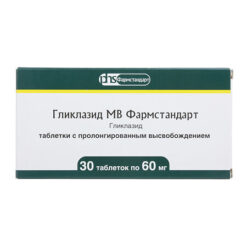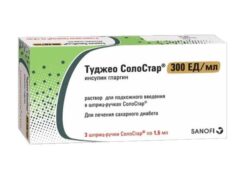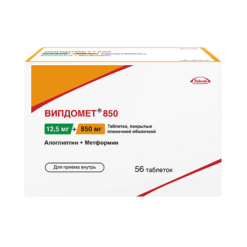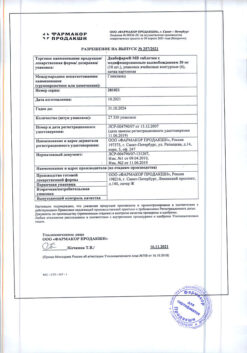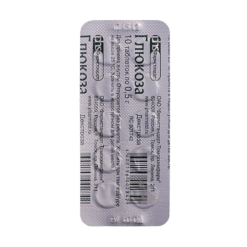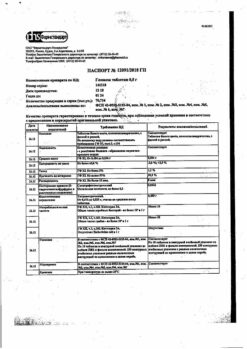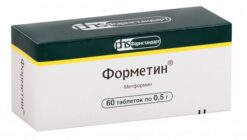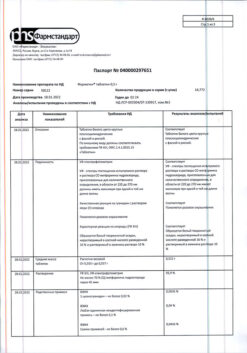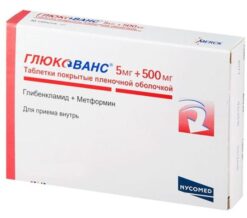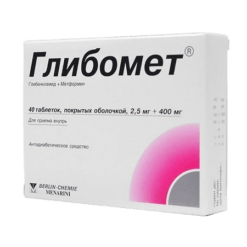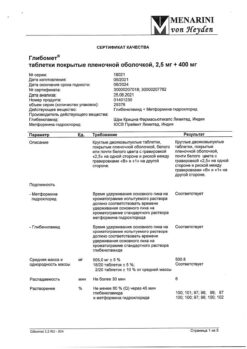No products in the cart.
Gliclazide MB, 30 mg 60 pcs
€4.78 €4.25
Description
Gliclazide is a sulfonylurea derivative, an oral hypoglycemic drug that differs from similar drugs by the presence of an N-containing heterocyclic ring with an endocyclic bond. Gliclazide reduces blood glucose concentration by stimulating insulin secretion by β-cells of Langerhans islets. Increase of concentration of postprandial insulin and C-peptide is maintained after 2 years of therapy.
In addition to the effect on carbohydrate metabolism, gliclazide has hemovascular effects. In type 2 diabetes, gliclazide restores the early peak of insulin secretion in response to glucose intake and increases the second phase of insulin secretion. A significant increase in insulin secretion is observed in response to stimulation caused by food intake or glucose administration. Gliclazide reduces the risk of small vessel thrombosis by affecting the mechanisms that may contribute to the development of complications in diabetes: partial inhibition of platelet aggregation and adhesion and decrease of platelet-activating factors (beta thromboglobulin, thromboxane B2) and restoration of fibrinolytic activity of vascular endothelium and increase of tissue plasminogen activator activity.
Intensive glycemic control based on the use of gliclazide with modified release (target glycosylated hemoglobin (HbA1c) < 6.5%) significantly reduces the risk of micro- and macrovascular complications of type 2 diabetes compared to standard glycemic control (ADVANCE study).
Indications
Indications
Type 2 diabetes mellitus with insufficient effectiveness of diet therapy, physical activity and weight loss.
Prevention of diabetes complications: reducing the risk of microvascular (nephropathy, retinopathy) and macrovascular complications (myocardial infarction, stroke) in patients with type 2 diabetes through intensive glycemic control.
Pharmacological effect
Pharmacological effect
Gliclazide is a sulfonylurea derivative, a hypoglycemic drug for oral administration, which differs from similar drugs in the presence of an N-containing heterocyclic ring with an endocyclic bond. Gliclazide reduces blood glucose concentrations by stimulating insulin secretion by β-cells of the islets of Langerhans. Increases in postprandial insulin and C-peptide concentrations persist after 2 years of therapy.
In addition to its effect on carbohydrate metabolism, gliclazide has hemovascular effects. In type 2 diabetes mellitus, gliclazide restores the early peak of insulin secretion in response to glucose and enhances the second phase of insulin secretion. A significant increase in insulin secretion is observed in response to stimulation caused by food intake or glucose administration. Gliclazide reduces the risk of thrombosis of small vessels by influencing mechanisms that can cause the development of complications in diabetes mellitus: partial inhibition of platelet aggregation and adhesion and a decrease in the concentration of platelet activating factors (beta thromboglobulin, thromboxane B2), as well as restoration of fibrinolytic activity of the vascular endothelium and increased activity of tissue plasminogen activator.
Intensive glycemic control based on the use of modified-release gliclazide (target glycosylated hemoglobin (HbA1c) < 6.5%) significantly reduces the risk of micro- and macrovascular complications of type 2 diabetes mellitus compared with standard glycemic control (ADVANCE study).
Active ingredient
Active ingredient
Gliclazide
Composition
Composition
1 tablet contains the active substance:
Gliclazide – 30.0 mg
Contraindications
Contraindications
Hypersensitivity to gliclazide or any of the excipients of the drug, other sulfonylurea derivatives, sulfonamides; type 1 diabetes mellitus; diabetic ketoacidosis, diabetic precoma, diabetic coma; severe renal or liver failure; taking miconazole; pregnancy and lactation; age up to 18 years.
It is not recommended to use the drug simultaneously in combination with phenylbutazone or danazol.
Side Effects
Side Effects
Hypoglycemia (in case of violation of the dosage regimen and inadequate diet): headache, increased fatigue, hunger, increased sweating, severe weakness, palpitations, arrhythmia, increased blood pressure, drowsiness, insomnia, agitation, aggressiveness, anxiety, irritability, impaired concentration, inability to concentrate and delayed reaction, depression, visual impairment, aphasia, tremor, paresis, sensory disorders, dizziness, feeling of helplessness, loss of self-control, delirium, convulsions, shallow breathing, bradycardia, loss of consciousness, coma.
From the digestive system: nausea, vomiting, diarrhea, abdominal pain, constipation (the severity of these symptoms decreases when taken with food); rarely – liver dysfunction (hepatitis, cholestatic jaundice – requires discontinuation of the drug, increased activity of liver transaminases, alkaline phosphatase).
From the hematopoietic organs: inhibition of bone marrow hematopoiesis (anemia, thrombocytopenia, leukopenia, granulocytopenia).
Allergic reactions: skin itching, urticaria, skin rash, incl. maculopapular and bullous), erythema.
Other: visual impairment.
Common side effects of sulfonylurea derivatives: erythropenia, agranulocytosis, hemolytic anemia, pancytopenia, allergic vasculitis; life-threatening liver failure.
Interaction
Interaction
Gliclazide enhances the effect of anticoagulants (warfarin); dose adjustment of the anticoagulant may be required.
Miconazole (when administered systemically and when using the gel on the oral mucosa) enhances the hypoglycemic effect of the drug (possible development of hypoglycemia up to the state of coma).
Phenylbutazone (systemic administration) enhances the hypoglycemic effect of the drug (displaces it from binding to plasma proteins and/or slows down elimination from the body); blood glucose monitoring and dose adjustment of gliclazide are necessary, both while taking phenylbutazone and after its discontinuation.
Ethanol and ethanol-containing drugs enhance hypoglycemia by inhibiting compensatory reactions and may contribute to the development of hypoglycemic coma.
When taken simultaneously with other hypoglycemic drugs (insulin, acarbose, biguanides), beta-blockers, fluconazole, angiotensin-converting enzyme inhibitors (captopril, enalapril), H2-histamine receptor blockers (cimetidine), monoamine oxidase inhibitors, sulfonamides and non-steroidal anti-inflammatory drugs (NSAIDs) – increased hypoglycemic effect and risk of hypoglycemia.
Danazol has a diabetogenic effect. It is necessary to monitor blood glucose levels and adjust the dose of gliclazide, both while taking danazol and after its discontinuation.
Chlorpromazine in high doses (more than 100 mg/day) increases blood glucose levels, reducing insulin secretion. It is necessary to monitor blood glucose and adjust the dose of gliclazide, both while taking chlorpromazine and after its discontinuation
GCS (systemic, intra-articular, external, rectal use) increase blood glucose levels with the possible development of ketoacidosis (decreased tolerance to carbohydrates). It is necessary to monitor blood glucose and adjust the dose of gliclazide, both while taking GCS and after their withdrawal.
Ritodrine, salbutamol, terbutaline (intravenous administration) – increase blood glucose levels. It is recommended to monitor blood glucose and, if necessary, transfer the patient to insulin therapy.
Overdose
Overdose
Symptoms: hypoglycemia, impaired consciousness, hypoglycemic coma. Treatment: if the patient is conscious, take sugar orally.
Severe hypoglycemic conditions may develop, accompanied by coma, convulsions or other neurological disorders. If such symptoms appear, emergency medical care and immediate hospitalization are necessary.
If a hypoglycemic coma is suspected or diagnosed, the patient is quickly injected intravenously with 50 ml of a 40% dextrose (glucose) solution. Then a 5% dextrose (glucose) solution is injected intravenously to maintain the required level of glucose in the blood.
After regaining consciousness, it is necessary to give the patient food rich in easily digestible carbohydrates (to avoid re-development of hypoglycemia). Careful monitoring of blood glucose levels and observation of the patient should be carried out for at least the next 48 hours. After this period of time, depending on the patient’s condition, the attending physician decides on the need for further observation. Dialysis is ineffective due to the pronounced binding of gliclazide to plasma proteins.
Storage conditions
Storage conditions
In a place protected from light, at a temperature not exceeding 25 °C.
Shelf life
Shelf life
3 years
Manufacturer
Manufacturer
Ozon, Russia
Additional information
| Shelf life | 3 years |
|---|---|
| Conditions of storage | In a light-protected place at a temperature not exceeding 25 °C. |
| Manufacturer | Ozon, Russia |
| Medication form | controlled release tablets |
| Brand | Ozon |
Other forms…
Related products
Buy Gliclazide MB, 30 mg 60 pcs with delivery to USA, UK, Europe and over 120 other countries.


